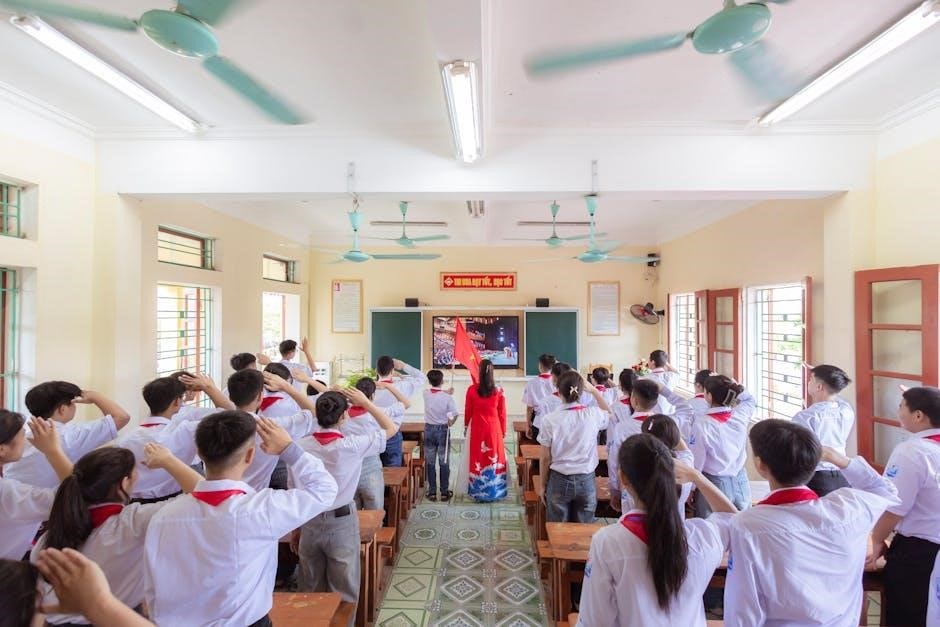small group instruction pdf
Small group instruction is a versatile and effective teaching strategy that enhances learning outcomes by allowing personalized attention and fostering collaborative environments․ It enables educators to address diverse academic needs, promote active participation, and tailor lessons to individual student requirements, making it a valuable approach for inclusive and differentiated education․ This method not only improves academic performance but also encourages meaningful interactions between teachers and students, creating a supportive and engaging classroom atmosphere․ By implementing small group instruction, educators can cater to varied learning styles and abilities, ensuring equitable opportunities for all students to thrive academically․
Definition and Overview
Small group instruction is a teaching strategy involving smaller student groups, allowing personalized attention and tailored instruction․ It enhances academic outcomes, engagement, and collaboration, fostering a focused learning environment․
What is Small Group Instruction?
Small group instruction is a structured teaching method where students are divided into groups of 3–8 to receive targeted, personalized instruction․ It allows teachers to address diverse learning needs, reinforce concepts, and provide immediate feedback․ This approach is particularly effective for reading, math, and language skills, enabling students to engage actively and build confidence in a supportive environment;
Key Characteristics
Small group instruction is characterized by its targeted focus, allowing teachers to address specific student needs․ Groups are typically small, ranging from 3–8 students, enabling personalized attention․ Lessons are often short, structured, and skill-based, with opportunities for active participation․ This method emphasizes differentiated instruction, scaffolded learning, and immediate feedback, fostering a collaborative and engaging learning environment tailored to diverse abilities and learning styles․

Benefits of Small Group Instruction
Small group instruction enhances learning outcomes by providing tailored support, fostering engagement, and encouraging collaboration․ It allows for personalized feedback, addressing individual needs effectively while promoting academic growth․
Improved Academic Outcomes
Small group instruction significantly enhances academic performance by allowing educators to address individual learning gaps․ Students receive targeted support, leading to better comprehension and retention of concepts․ Research indicates that small group settings foster higher levels of achievement, particularly for struggling learners․ The ability to provide differentiated instruction ensures that each student’s needs are met, resulting in measurable improvements in test scores and overall academic success․
Increased Student Engagement and Participation
Small group instruction fosters increased student engagement and participation by creating an environment where students feel comfortable contributing․ Educators can more easily encourage shy or hesitant learners, promoting active involvement․ Interactive activities tailored to smaller groups enhance focus and motivation, leading to higher levels of student interaction and collaboration․ This personalized approach ensures that every student has opportunities to engage meaningfully with the material․
Personalized Learning Opportunities
Small group instruction allows educators to tailor teaching strategies to meet individual student needs, fostering personalized learning․ Teachers can assess student understanding in real-time and adjust instruction accordingly․ Differentiated approaches enable targeted support, ensuring each learner receives relevant challenges or scaffolding․ This personalized attention enhances comprehension, confidence, and overall academic growth, making learning more meaningful and effective for all students in the group․

Effective Strategies for Implementation
Effective strategies for small group instruction include clear goal setting, ongoing assessment, and fostering a collaborative classroom culture to enhance student engagement and learning outcomes effectively․
Forming and Managing Small Groups
Forming small groups involves assessing student strengths, weaknesses, and learning goals to create balanced teams․ Teachers should consider grouping strategies like homogeneous or heterogeneous grouping based on objectives․ Managing group dynamics requires clear expectations, defined roles, and active monitoring to ensure productivity․ Implementing group contracts and rotating leadership roles can foster accountability and collaboration․ Regular check-ins help address challenges and maintain focus, ensuring effective learning outcomes for all students․
Lesson Planning for Differentiated Instruction
Effective lesson planning for small group instruction requires tailoring content to meet diverse student needs․ Teachers create tiered activities based on assessment data, ensuring each group receives appropriate challenges․ Scaffolding techniques, such as graphic organizers or sentence frames, support struggling learners․ Integrating technology and real-world applications enhances engagement․ Lessons are designed to promote critical thinking, problem-solving, and collaboration, fostering a personalized and inclusive learning environment for all students․
Interactive Activities to Enhance Learning
Interactive activities, such as hands-on tasks, group discussions, and role-playing, foster active participation in small group instruction․ Think-pair-share and problem-solving challenges encourage collaboration and critical thinking․ Technology integration, like educational games or collaborative tools, enhances engagement․ These activities cater to various learning styles, making lessons dynamic and inclusive․ They also provide opportunities for immediate feedback, reinforcing learning objectives and promoting deeper understanding among students․

Best Practices for Educators
Establish clear expectations, actively monitor progress, and provide timely feedback․ Use differentiated instruction to meet diverse needs while fostering a collaborative and inclusive learning environment․
Managing Group Dynamics
Encourage respect, collaboration, and active participation among students․ Assign roles to promote accountability and structure․ Monitor interactions to address conflicts and ensure equity․ Provide incentives for teamwork and celebrate successes․ Foster a positive group culture by modeling constructive communication․ Use strategies like think-pair-share or group rotations to maintain engagement․ Offer feedback to improve dynamics and reinforce expectations; This approach helps create a supportive and productive learning environment, enhancing overall academic outcomes for all students․
Using Data to Inform Instruction
Regularly assess student performance to identify strengths and areas needing improvement․ Use formative assessments, exit tickets, and progress monitoring tools to gather actionable data․ Analyze results to adjust instruction, ensuring targeted support for each learner․ Data-driven decisions help differentiate instruction, address skill gaps, and enhance small group effectiveness․ This approach ensures personalized learning experiences and fosters measurable academic growth for all students in small group settings․
Encouraging Parental Involvement
Foster partnerships with parents by maintaining open communication and providing regular updates on their child’s progress․ Encourage parents to volunteer in small group settings or assist with homework aligned with classroom activities․ Involve them in parent-teacher conferences to discuss their child’s strengths and areas for growth․ Offering workshops or resources on supporting small group instruction at home strengthens the home-school connection and enhances student success․

Challenges and Considerations
Managing diverse learning needs, classroom disruptions, and time constraints are key challenges․ Educators must balance individualized attention with whole-class instruction․
Addressing Diverse Learning Needs
Small group instruction allows educators to cater to varying skill levels and learning styles․ Differentiated instruction strategies, such as scaffolding and tiered assignments, help meet individual needs․ Universal Design for Learning (UDL) frameworks can be integrated to ensure accessibility․ Formative assessments enable teachers to track progress and adapt instruction․ Leveraging technology and flexible grouping also supports diverse learners, fostering an inclusive and equitable learning environment․
Classroom Management Strategies
Educators can maintain order during small group instruction by establishing clear expectations and routines․ Visual reminders, such as charts or checklists, reinforce behavioral norms․ Strategically placing groups near the teacher minimizes disruptions․ Encouraging student accountability and using non-verbal cues helps manage transitions smoothly․ Rotating group roles, like leader or recorder, fosters responsibility and engagement, ensuring a focused and productive learning environment for all students․
Time Constraints and Scheduling
Effectively managing time is crucial for small group instruction․ Educators must allocate specific durations for each group, ensuring equitable access․ Schedules should balance group sizes and learning objectives․ Rotational models allow efficient use of class time․ Integrating technology can streamline transitions and minimize downtime․ Prioritizing tasks and using assessment data helps optimize scheduling to meet diverse student needs without overwhelming the instructor or students․

Applications Across Different Subjects
Small group instruction is versatile, enhancing learning in reading, math, science, and English․ It supports differentiated teaching, catering to diverse needs and fostering deeper subject understanding․
Reading Instruction
Small group instruction in reading allows for targeted support, enabling teachers to address specific skill gaps․ Strategies like guided reading, phonics interventions, and comprehension discussions thrive in this setting․ Teachers can scaffold learning, providing personalized feedback and fostering a deeper understanding of texts․ This approach also encourages active participation and peer interaction, enhancing overall literacy development․ By tailoring instruction to students’ needs, small groups create a supportive environment for improving reading proficiency and confidence․
Math Intervention
Small group instruction in math intervention allows teachers to provide targeted support for students struggling with specific concepts․ Strategies like guided practice, formative assessments, and manipulatives help reinforce understanding․ Teachers can address individual learning gaps, promoting mastery of foundational skills․ Interactive activities, such as problem-solving tasks, encourage collaboration and critical thinking․ This approach ensures personalized feedback, making math more accessible and engaging for all learners while fostering confidence and fluency in mathematical reasoning․
English Language Learners (ELL)
Small group instruction is highly effective for English Language Learners (ELL), as it provides opportunities for scaffolded language development and academic skill-building․ Teachers can use visual aids, simplified language, and hands-on activities to support comprehension․ Differentiated instruction allows ELLs to practice speaking, listening, and writing in a low-stakes environment․ Incorporating native language support and culturally responsive practices further enhances engagement and fosters an inclusive learning atmosphere for diverse learners․
Role of Technology
Technology enhances small group instruction by providing digital tools for interactive learning, real-time feedback, and personalized resources, fostering engagement and efficient collaboration among students and educators․
Digital Tools for Small Group Instruction
Digital tools like interactive whiteboards, online collaboration platforms, and educational apps enhance small group instruction by fostering engagement, streamlining communication, and providing personalized learning experiences․ Tools such as Kahoot! and Nearpod enable real-time assessments and feedback, while platforms like Google Workspace facilitate teamwork and resource sharing․ These technologies also support differentiated instruction, allowing educators to tailor activities to meet diverse student needs, promoting inclusivity and effective learning outcomes․
Blended Learning Approaches
Blended learning integrates digital and in-person instruction, enhancing small group dynamics․ Pre-recorded videos and online resources allow students to prepare individually, enriching group discussions․ Data from digital tools informs tailored instruction, addressing diverse needs․ Models like flipped classrooms maximize group time for application and deeper learning, fostering engagement and personalized growth, while supporting differentiated instruction to cater to varied learning styles and paces within small groups․

Professional Development
Professional development for educators focuses on enhancing small group instruction skills through workshops, training, and mentorship programs, ensuring effective implementation and continuous improvement in teaching practices․
Training and Workshops
Training and workshops on small group instruction provide educators with practical strategies to enhance teaching effectiveness․ These sessions often cover group dynamics, differentiated instruction, and interactive activities․ Educators learn how to create engaging lesson plans, manage group work, and integrate technology․ Hands-on exercises and real-world examples help teachers apply these methods in their classrooms, fostering a collaborative and supportive learning environment for students․ Regular professional development ensures sustained improvement in instructional practices․
Resources for Educators
Resources for educators on small group instruction include PDF guides, checklists, and templates to support lesson planning and implementation․ These materials often provide strategies for managing groups, differentiated instruction, and engaging activities․ Online courses, webinars, and educational blogs also offer valuable insights․ Many schools and organizations provide access to these tools, helping educators refine their skills and create effective small group learning experiences tailored to student needs․
Measuring Success
Measuring success in small group instruction involves using assessment strategies like formative and summative evaluations to track student progress and identify areas needing improvement, ensuring data-driven decisions․
Assessment Strategies
Educators use formative assessments like exit tickets, quizzes, and observations to monitor progress during small group instruction․ Summative assessments, such as unit tests or projects, evaluate long-term understanding․ Data from these assessments helps identify learning gaps, informing future lessons and ensuring personalized instruction․ Regular progress monitoring enables educators to adjust strategies, fostering improved academic outcomes and ensuring students meet learning objectives effectively․ This data-driven approach enhances the overall impact of small group instruction․
Student Feedback and Progress Monitoring
Regular student feedback and progress monitoring are crucial in small group instruction, allowing educators to track growth and adjust teaching strategies․ Formative assessments, such as exit tickets or quick quizzes, provide insights into student understanding․ One-on-one interactions enable personalized feedback, helping students identify strengths and areas for improvement․ This ongoing process ensures tailored support, fostering academic growth and confidence in learners․ Consistent monitoring also helps educators refine instruction to meet diverse needs effectively․

Case Studies and Research
Research on small group instruction shows improved academic outcomes, supported by empirical studies and meta-analyses highlighting its effectiveness in enhancing student learning and engagement․
Meta-Analyses and Empirical Evidence
Meta-analyses consistently demonstrate the effectiveness of small group instruction, showing significant academic gains, particularly in reading and math․ Empirical studies highlight improved engagement, better retention, and personalized learning opportunities․ Research underscores the importance of targeted interventions and differentiated instruction, with positive outcomes for diverse learners․ These findings emphasize the role of small group instruction in addressing individual needs and promoting equitable education, supported by robust data and teaching strategies․
Success Stories from the Classroom
Teachers report significant improvements in student performance when implementing small group instruction․ For instance, a 4th-grade class saw a 20% increase in reading fluency after targeted small group sessions․ Similarly, middle school math teachers noted enhanced problem-solving skills in students who participated in structured small group activities․ These success stories highlight the practical benefits of small group instruction in fostering academic growth and student confidence․

Cultural Considerations
Cultural diversity in classrooms requires educators to adapt small group instruction strategies to accommodate varied learning styles, communication preferences, and social norms, ensuring inclusive and equitable learning environments․
Teaching in Diverse Classrooms
Small group instruction in diverse classrooms requires cultural responsiveness to meet the unique needs of students from varied backgrounds․Educators must adapt teaching strategies to accommodate different learning styles, languages, and cultural norms while fostering an inclusive environment․Using culturally relevant materials and promoting collaborative group activities can enhance engagement and ensure all students feel valued and supported in their learning journey․
Inclusivity and Equity in Instruction
In small group instruction, fostering inclusivity and equity ensures all students receive fair opportunities to learn․ Educators must recognize and address individual needs, providing differentiated support while promoting a sense of belonging․ Equitable practices involve allocating resources and attention equally, allowing diverse learners to thrive․ Inclusive instruction creates a supportive environment where every student’s voice is heard and valued, regardless of their background or abilities․

References and Further Reading
Explore PDF resources like “Small Group Instruction Best Practices” and “Differentiated Instruction Guides” for in-depth strategies․ Visit educational websites for additional materials and research-based approaches․
PDF Resources
Access comprehensive guides like “Small Group Instruction Strategies” and “Effective Small Group Teaching” in PDF format․ These resources offer practical tips, lesson templates, and evidence-based approaches․ Many educational websites provide free downloadable PDFs on differentiated instruction, classroom management, and engagement techniques․ Search for “small group instruction strategies PDF” to find curated materials․ Websites like ASCD and Edutopia often feature downloadable guides for educators․
Books and Journals
Explore books like “Small Group Instruction: A Research-Based Approach” and “Differentiated Instruction in the Classroom” for in-depth insights․ Journals such as Journal of Educational Research and Teaching Exceptional Children publish studies on small group instruction․ These resources provide evidence-based strategies, practical applications, and research findings to enhance teaching practices․ They are invaluable for educators seeking to refine their instructional methods and stay updated on best practices in education․
